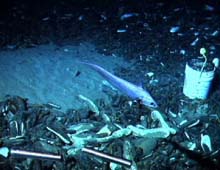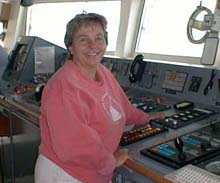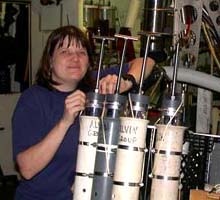The 'Quest' Starts with Questions
September 28, 2001
Paula Keener-Chavis, Director
South Carolina Statewide Systemic Initiative's Charleston Math and Science Hub
Deep East Education Project Coordinator
Andy Shepard, Associate Director
National Undersea Research Center
University of North Carolina, Wilmington
Strange and beautiful things were brought to us from time to time, which seemed to give us a glimpse of some unfamiliar world. -- Sir Charles Wyville Thomson, The Challenger Expedition, 1876
Science is an evolutionary process that begins with hypotheses -- essentially, well-informed questions. From the beginning of the Deep East Expedition, we have maintained that exploration is a process of discovery. We intentionally set out to ask more questions than we will answer about extreme environments in the deep sea. Indeed, the true process of scientific inquiry was at the core of the expedition.
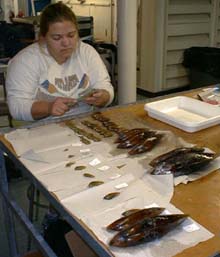
Mussels are sized, weighed, and dissected to study population structure and physiology. Click on image for a larger view.
As is unquestionably the case in any process of exploration and discovery, the window has now been opened at the Blake Ridge for the development of an unlimited number of hypotheses. It is only through attempts to address these hypotheses that we can begin to unfold the mysteries of the extreme environments found here. What follows are just a few of the questions that have been generated in the past five days of deep-sea exploration. These questions will surely drive new investigations of the extreme environments found under the ocean during the third and final leg of Deep East.
Unusual Species
The mussels here at Blake Ridge are unusually large. Is this because they grow quickly, or do they grow slowly and live to be quite old? If they are slow-growing and long-lived, is this because few predators inhabit the ridge, as compared to other sites where smaller mussels are found? Understanding mussel growth rates may offer insight into many other factors, such as the flux of methane at the site.
Xenophyophores are not your everyday single-celled animal. Like the mussels here, they are very large compared to other, related species. They live in complex, golf-ball-sized houses constructed of sand grains. Their occurrence at Blake Ridge is the first documented finding of these strange creatures at seep sites (they have yet to be found in the Gulf of Mexico). Are conditions at Blake Ridge especially conducive to these protists? Again, understanding their distribution helps our understanding of seep ecology.
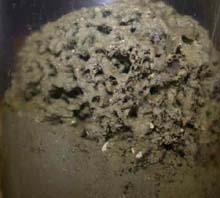
This single-celled organism, called a xenophyophore, is about the size of a golf ball. Although these unusual organisms are common in the deep sea, this is the first time they have ever been found at a seep site. Click image for larger view.
The species of clams we collected also have yet to be seen at seeps in the Gulf of Mexico. Chemosynthetic clam species in the Gulf have symbiotic bacteria that use hydrogen sulfide, not methane, for energy. Do these clams have symbionts, and are they capable of using methane as a source of energy? We are coming to realize that chemosynthesis is common in the deep sea—which includes most of the Earth’s biosphere—yet, we still know much less about how it works than we do about photosynthesis, for example.
Habitat Features
We watched hydrates in the making in a deep-sea natural setting. Previously, the gas hydrates at Blake Ridge have been described as "dirty," or dispersed through the sediments. When we arrived here, however, we were surprised to find large, exposed outcrops of hydrate on the sea floor. How are hydrates distributed on the ridge, and how does the rate of flux of methane control their distribution? Blake Ridge offers a natural laboratory in which to study how hydrates form and dissociate over time.
Our multibeam surveys clearly defined long ridge and furrow features at the site. Are these deep-sea sediment wave fields more common features on continental margins than previously believed, and do they play a key role in perturbing the underlying gas hydrate reservoir? Do differential erosion and sedimentation at these locations perturb the gas hydrate, making these sediment wave fields places where methane (carbon) can escape from the sea floor and into the ocean?
When the Ocean Drilling Program selected the Blake Ridge as its first area to drill for gas hydrates in 1995, its target site was a salt diapir, a mushroom-shaped pillar of salt that pushes up through the sediments. The pressure causes fissures in the overlying substrate, which act as conduits for the flow of gas to the sea floor. Hole 996 was one of five such features that were drilled, and the only one we have visited during the past week. Will we see the same types of communities and flux indicators at the other well sites? About a dozen more diapirs are found near the Blake Ridge; is this a chain of seep sites yet to be explored?
(top)
Interview with Mitzi Crane
Chief Mate, R/V Atlantis
Ocean Explorer Team: What do your duties aboard the R/V Atlantis entail?
Mitzi Crane: I serve as chief mate on board the R/V Atlantis. The chief mate is second in command of the vessel and a watch standing officer. I am assigned to the 0400-0800 and 1600-2000 navigation watch. My collateral duties include being the chief medical officer. Although it isn't my favorite job, I haven’t lost a patient yet. If someone gets really sick or badly hurt, we call a staff of doctors to help advise us on proper treatment and care.
Another of my duties is chief firefighter and damage control officer. If a fire breaks out, the crew and I muster to our damage-control lockers, don firemen’s outfits and prepare to fight the fire. We have been very fortunate not to have had a fire on board, but we drill every week just to be prepared. The team and I invent various scenarios and practice new techniques. Part of my job is to train new crew members in safety awareness and response. Another duty is HAZMAT officer. As such, I am in charge of making sure all the chemicals, gases, and isotopes that the scientists bring out to use on their experiments are properly stowed, and that MSDS (material safety data sheets) are available.
I'm also in charge of the deck department, maintenance of deck equipment, requisitioning supplies for deck and hospital, and ensuring that the trash and garbage is separated and disposed of properly. Administrative duties include scheduling of swimmers and Alvin operators, monitoring overtime, crew evaluations, vacation rotation, and clerical duties. The ship is a 24-hour-a-day operation that requires each crew member to do his job to keep things running smoothly. We have such a good team that we even have time to watch movies, do laundry, eat, sleep, and play ping-pong!
Ocean Explorer Team: What type of background do you have?
Mitzi Crane: I graduated from the Maine Maritime Academy with a bachelor of science in nautical science and with a third-mate's license. With my onboard experiences, I worked my way up to master.
Interview by Caren A.D. Menard of the Ocean Explorer Team.
Interview with Lorene Smith
Research Associate
Louisiana State University (LSU)
Ocean Explorer Team: What is your role on the Deep East Expedition?
Lorene Smith: I am assisting Dr. Barun Sen Gupta on this expedition. When the push cores come up from the Alvin dives, I process the samples and prepare more cores for the next day’s dive. I keep his log book and I will be involved in data management for his project once we return. Back at the LSU lab at LSU, I will sieve and sort the samples of benthic Foraminifera.
Ocean Explorer Team: As a research associate, what is your perspective on the expedition?
Lorene Smith: Of all the research cruises in which I've participated, cruises on the R/V Atlantis have been the most exciting. This is my second cruise on this ship, and it seems that we always find something new.|
Ocean Explorer Team: Who or what influenced you to study ocean sciences?
Lorene Smith: In 4th grade, we were asked what we wanted to be when we grew up and I said that I wanted to be a marine biologist. I think that it was due to reading Skin Diver Magazine at the local library. I took a summer course in marine ecology offered by the Louisiana Universities Marine Consortium (LUMCON), which was the first time I had the opportunity to work with benthos (bottom-dwelling organisms). Soon after that, I got a student job working with benthic organisms from a hypoxic area of Lake Pontchartrain. After graduating from the University of New Orleans, I got a job working at LUMCON, studying benthic organisms from hypoxic areas in the Gulf of Mexico.
Sign up for the Ocean Explorer E-mail Update List.

































